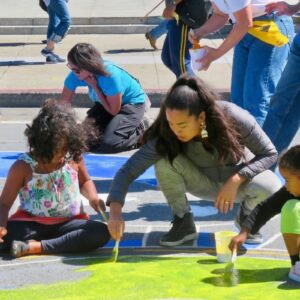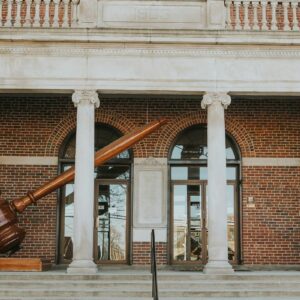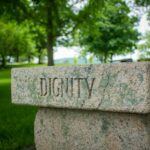
State of the Movements is a recurring NPQ column dedicated to tracking the pulse of social movements and the solidarity economy in 2025.
“What do we want? Asset-based community development! When do we want it? Now!”
That is a chant that I am pretty sure has never been uttered at a rally anywhere.
Nonetheless, many movement activists, knowingly or otherwise, depend on asset-based community development—better known by its initials “ABCD”—to guide their theory and practice. For this reason, breaking down what ABCD has to say about our present moment—and the role movements can play within it—is important.
The (Modern) Birth of ABCD
ABCD was born in 1990 through the work of John McKnight and John (Jody) Kretzmann with the release and reaction to a large green book entitled Building Communities from the Inside Out: A Path Toward Finding and Mobilizing a Community’s Assets.
This “big green book,” as it is affectionately known, offered recommendations from a four-year learning journey undertaken by John, Jody, and a small research team from Northwestern University. They spent this journey “sitting at the feet of neighbors” across the United States, asking and documenting over 2,000 answers to the simple question, “Can you tell me a story of what someone here has done to make things better?”
A core motivation behind this journey was to provide a much-needed counternarrative to the common racist perception that neighborhoods of color were helpless, hopeless communities. The “big green book” boldly challenged this “deficiency lens,” noting that successful community change starts with those who are most impacted by an issue or most invested in a possibility acting together as drivers of that change, drawing first upon what they have, what is there, or assets, rather than looking first outside of the community.
Key Aspects of an Asset-Based Approach
But what does this have to do with movement building? More than may at first be apparent. Some core ABCD practices include the following:
- Emphasis on Community Members’ Capacities and Leadership: First, ABCD is deeply and highly relational and person-centered. When carried out well, asset-based practices take care to center community members and their capacities as core producers, creators, and drivers of the changes that will impact them. Allison Lourash, co-president of the ABCD Institute, explained to NPQ that ABCD is: “Community-first in all things. Bottom-up, community focused, and looking at the strengths of community members who are most impacted.”
Neal Gorenflo, recent ABCD network weaver and former Shareable coeditor, explained to NPQ that the movement is intensely “committed to the dignity of the people involved in any organizing effort. Seeing them as whole people with capability and assets to offer others.” He added, “That is different than some other movements which I think unintentionally instrumentalize the participants.”
- Relationship Building and Connectors: Related to this, ABCD has uniquely illuminated the critical nature of the often unseen and undervalued work of relationship building—and the connectors who tend to carry out that weaving work—within neighborhoods and communities. As a connector myself, it wasn’t until I encountered this framework that I felt so deeply seen and validated in my many odd inclinations, dating back to my weird obsession with collecting business cards as a kid, the joy I find in hosting parties and introducing friends, or my natural inclination when meeting anyone to then introduce them to two or three people I know who could use their skill, care about something they care about, or just for some reason remind me of them.
By building these connections, connectors play the critical role of “making the invisible visible” by raising others’ awareness of often hidden assets within local individuals and groups. For examples of the powerful role connectors can play in community building, see the stories of Broadway Church in Indianapolis, IN; Westwood Unidos in Denver, CO; and the Free Library of Philadelphia’s Paschalville Partnership project.
- Critique of Hyper-Professionalization: ABCD’s human-centeredness leads into core critique of that which in modern times often acts as a barrier to community members freely giving and receiving care, skills and gifts, or exercising their agency and self-determination together with others.
In his book The Careless Society, McKnight indicts the ways paid professionals, agencies, and organizations outside of communities harm them by replacing, disrupting, and ultimately discouraging the leadership, self-determination, collaboration, and mutual care of community members by taking over functions those residents historically played. (See: John Deere and the Bereavement Counselor.)
- The Power of Associations: ABCD emphasizes the value of resident-led associations for organizing strong communities and supporting hyperlocal, sustainable innovation. In their paper Voluntary Associations in Low-Income Neighborhoods, McKnight, Kretzmann, and Nicol Turner demonstrate not only the wealth and diversity of such associations, but also the willingness of most associations to do more, if only someone would ask.
- Recognition of People’s Gifts and Leadership: ABCD has brought into sharper focus the importance of seeing, valuing, and finding a place for the gifts, talents, and leadership of individuals within communities who are typically marginalized. These groups include people living with disabilities, people experiencing homelessness, people with low or no incomes, young people (especially those labeled as “at risk”), elderly community members, and individuals engaging in crimes or those who have been formerly incarcerated.
ABCD argues that, rather than separating such people off from the community, the focus should be on identifying the strengths and dreams of these community members. There are a great many initiatives and networks focused on this practice, including the people behind Inclusion.com. You can also find inspiration in this TEDx presentation by Beth Mount.
- Hyperlocal, Place-Based, Neighborhood Focus: You might have heard the saying: “Think globally, act locally.” This is a core ABCD principle and speaks to ABCD’s influence on movements today. A place-based neighborhood focus can help reduce loneliness, build meaningful and accessible bonds of mutual aid, respond effectively to disasters, reduce our dependency on fossil fuels, increase sustainability, reduce polarization, and deepen democracy.
The Evolution of ABCD
Over the last 30-plus years, the ABCD movement has continued to spread and evolve across the globe. As ABCD has grown, networks have formed to bring the practice into national and regional contexts, including in Asia-Pacifica, South Africa, Canada, and Vietnam, to name a few.
The graphic below illustrates how ABCD principles have been adapted by different global practitioners. It has influenced not only the fields of community organizing and development but also the fields of health, disability, municipal government, philanthropic organizations, nonprofits, peace building and violence prevention, libraries, museums, social services, and more.

[Additional reference information available here.]
Through both global and national gatherings over the decades, practitioners of all levels have met to exchange their stories and innovations, build relationships, and gain new tools to bring home. Thanks to its decentralized nature, as well as its breadth, tracking the true evolution and impact of the ABCD movement is probably an impossible task.
Of course, there are growing pains along the way. As the practice has spread globally, the ABCD Institute has shifted from a founder-driven “Circle of Friends” to a more overtly structured, diverse, collectively led, and network-oriented model. As Lourash shared, “We still struggle with this idea of not wanting to have that ‘institutional’ sense of things.”
Yet as we move toward a structure for organizing ourselves that more fully mirrors the movement’s inherently relational and organic nature—that of a network—the potential is ripe for greater cross-pollination and collective evolution.
Realizing ABCD’s Potential
Kretzmann, coauthor of the “big green book,” would often say “ABCD is important but not sufficient.”
There is immense power to be gained from the inner shift that takes place as one puts on “asset lenses” to genuinely investigate not only the gifts, talents, capacities, and willingness to act within others, but also within oneself. But for ABCD to realize its full potential, challenges remain. These include the following:
- Addressing Systems of Oppression: The original framing and literature of ABCD often results in understating structural barriers and systemic disadvantages faced by many people and neighborhoods due to race, class, gender, ability, or other factors. While many current leaders seek to remedy this, it takes intentionality.
- Honoring Roots: Related to this, ABCD can easily come across as a methodology “invented” by two White men, even if it was just naming practices well-known within historically oppressed communities. While I have witnessed trainers becoming more intentional about naming this, the tension persists.
- Engaging Economics: While many social change movements have come to acknowledge the fundamentally extractive, alienating, damaging, and ultimately unsustainable nature of the capitalist economic system, ABCD as a field has not. The Coady Institute, however, has made significant contributions to the intersections of asset-based and economic thinking. And the Post Growth Institute, which has popularized the Offers and Needs Market across the globe, offers an example of blending asset-based and solidarity economy practices.
- Connecting with Traditional Community Organizing: There is ongoing tension in the historic and ongoing lack of integration between social justice or campaign-based organizing and asset-based approaches. One effort to remedy this is the book Pulling Together by Tom Mosgaller and Mike Breininger.
- Breaking Down Silos: Both asset-based practitioners and changemakers in other social change spaces recognize that now is absolutely the time to step out of the silos that have historically separated us. For instance, over the last three years, I have found great enthusiasm about ABCD within the Resist & Build process, a pluralistic system change space, where I recently held an energy-filled learning exchange event exploring “ABCD and the Solidarity Economy” with the support of the ABCD Institute along with other partners.
- Addressing Rural Realities: Much of the early research informing ABCD occurred in urban neighborhoods. To meet rural needs, there has been ongoing work to be more inclusive of rural communities’ cultures, challenges, assets, and realities. (This ABCD Unconference session is one example.)
The Relevance of ABCD in This Moment and Beyond
As we struggle to make sense of the turbulence of our times, what is the unique relevance of ABCD to movements today?
We are living in immensely trying times—filled with heightening danger, dehumanization, alienation and isolation, devastation, precarity, and despair. We can also likely count on things getting harder rather than easier. Like many, my heart struggles to conceive of the world my daughter will inherit, let alone how to prepare her for it.
Lourash offered this perspective:
Angela Blanchard, who works in disaster relief spaces and takes the ABCD community approach says, “Nobody is going to come and save you. You have to save yourself.” When I look at what is going on in the world today, as much as I protest or do other things in other movements in relation to everything that’s going on right now that’s so disheartening, I think recognizing that when things shift and things change, when we’re going to have a pendulum swing, there still needs to be a bottom-up approach.”
Decimating Medicaid cuts, for example. After all that advocacy, part of that is relational work…boots on the ground, advocates who are attending office hours and having conversations. You know, going out and getting arrested, people who get worked up, there is a role for that….But there’s also a role for mutual aid. And even if you have a well-funded, well-built system, you’re still going to need community.
Neal Gorenflo built on this: “I think ABCD can be a tool to rebuild our civic infrastructure, our civic culture. As a stronger foundation to rebuild our larger democracy. To bridge ideological and other divides.”
I have been heartened to see growing awareness in movement spaces for the critical work of both individual and communal healing, grieving, and looking beyond the material or even our social relationships for the strength, wisdom, and wholeness that we need now and into this complex future.
What ABCD might offer in this time goes beyond its conceptual lens or a set of tools. Rather, the heart of this movement’s offering may lie in its trained focus on that “special something” that people—all people—have within them, which is held individually but only truly ignited collectively.
As John Zeigler, long-time Chicago organizer, director of the Egan Office of Urban Education and Community Partnerships (UECP) at DePaul University, and senior director of programs at the Goldin Institute, told NPQ,
[This work] holds a spiritual space…When you care enough to be that changemaker, that’s a lot of heart. The heart is uneducable. You just feel….People do care, people do share, they share themselves. They become movement makers in their own spaces. That’s a spiritual movement as well. That’s a huge heart piece and I’m intrigued by that…by why people do the extra. I’m intrigued by the spiritual components of ABCD that produce a different understanding of care, of movements, of camaraderie, of connecting to the unknown.
Perhaps an asset lens offers a particular piece of that profound restorative healing—grounded in care and abundance—that we need right now to chart our very uncertain future.














